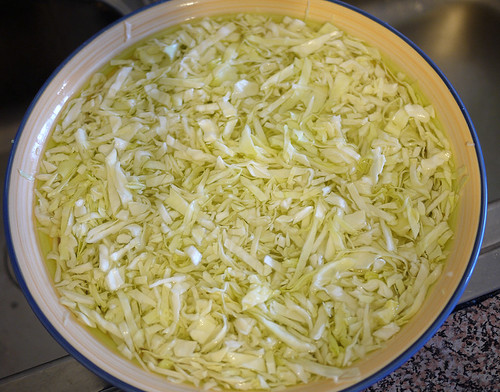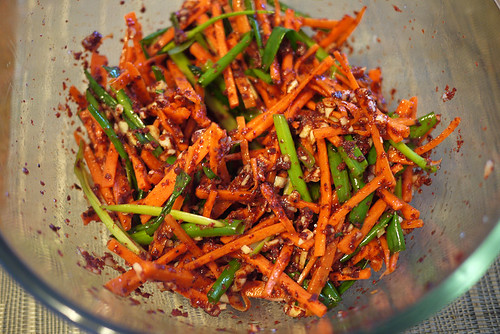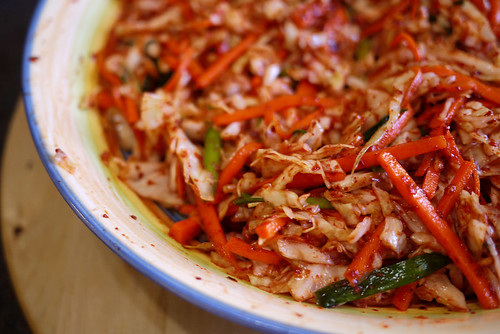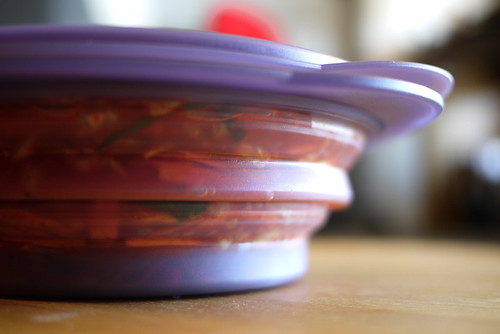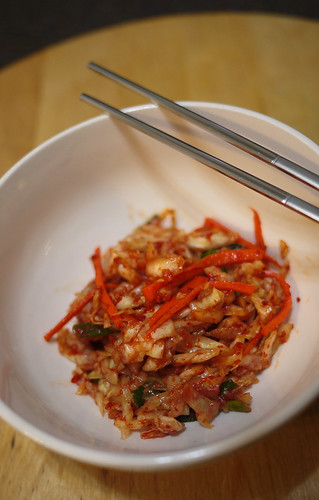I've been learning how to cook Korean cuisine for the past weeks because other than wanting to learn cooking different cuisines, my Husband and I really enjoy eating Korean food. Last weekend, I was able to cook three Korean dishes. I felt very good being able to practice what I've read about Korean cuisine and very happy because my Husband loved them.
While there are Asian grocery stores in our area and they usually sell Korean marinades and packed Kimchi, I love that I'm able to make my own Korean marinades and Kimchi. And as much as possible, I avoid buying bottled marinades because they are sometimes high in salt, sugar or preservatives.
There are different ways of making Kimchi. I got the inspiration of this recipe from a Korean Blogger named Maangchi where she shared a few Kimchi recipes in her site.
The traditional Kimchi is made with Napa Cabbage, but this recipe uses the common cabbage we see in the markets. One of the things I learned when we visited the Kimchi Museum in Seoul, Korea was that any vegetable is a probable candidate to be "kimchi-ed".
I chose this recipe of Maangchi because this is the easiest and less complicated. I made a few changes on the measurements of the ingredients because I based it on my family's taste and tolerance for spice. I suggest that if you make your own Kimchi at home, season as you mix so the taste will also be based on your preference. You can just use my measurements as a guide. The Kimchi I made was just medium spicy; not too hot.
While there are Asian grocery stores in our area and they usually sell Korean marinades and packed Kimchi, I love that I'm able to make my own Korean marinades and Kimchi. And as much as possible, I avoid buying bottled marinades because they are sometimes high in salt, sugar or preservatives.
There are different ways of making Kimchi. I got the inspiration of this recipe from a Korean Blogger named Maangchi where she shared a few Kimchi recipes in her site.
The traditional Kimchi is made with Napa Cabbage, but this recipe uses the common cabbage we see in the markets. One of the things I learned when we visited the Kimchi Museum in Seoul, Korea was that any vegetable is a probable candidate to be "kimchi-ed".
I chose this recipe of Maangchi because this is the easiest and less complicated. I made a few changes on the measurements of the ingredients because I based it on my family's taste and tolerance for spice. I suggest that if you make your own Kimchi at home, season as you mix so the taste will also be based on your preference. You can just use my measurements as a guide. The Kimchi I made was just medium spicy; not too hot.
What you need:
1/2 head of medium sized Cabbage (cut into strips)
1/4 cup Hot Pepper Flake
3-5 tbsps Fish Sauce (depends on your taste)
1 tbsp Sugar
1/4 cup minced Garlic
4 stalks Green Onion (cut into strips)
1 medium-sized julienned Carrot
1 cup cold water
1/4 cup Salt
What you need to do:
1. Cut your cabbage into strips and place into a large bowl.
2. Add 1 cup of cold water and 1/4 cup salt. With use of your hands, mix it well to properly salt the cabbage.
3. Set aside for 10 minutes.
3. Set aside for 10 minutes.
4. Make the Kimchi Paste by mixing the following ingredients:
1/4 cup hot pepper flakes (you can lessen or add depending on how spicy you want it to be)
1 tbsp sugar
3-5 tbsps Fish Sauce (saltiness should be based on your taste)
1/4 cup minced Garlic
4 stalks Green Onion (cut into strips)
1 medium-sized julienned Carrot
5. Wash and rinse the salted cabbage in cold water for about 2-3 times then drain.
6. Mix the Kimchi Paste into the cabbage thoroughly. Better to use your hands in mixing.
7. Put the Kimchi into a container or jar.
8. Press the top of the Kimchi down with your hands to protect your Kimchi from being exposed to too much air. Seal container tightly.
You can eat this Kimchi right away and call it fresh Kimchi. If you want to ferment the Kimchi, keep it at room temperature for a few days. I fermented my Kimchi for 3 days and then stored it inside the refrigerator.
If after a few days of fermentation and you find white stuff (mold) on top of the Kimchi, remove the top layer and the rest of Kimchi will still be good for the months and months.
